by Philip Wiles
Thanks to a generous grant from the Sidney E. Cohn and Lucille Lortel Chairs at the CUNY Graduate Center, I was able to arrange a short stay in Berlin (with a brief excursion to Hamburg) to see a number of plays at some of the city’s most preeminent theatres. Fortuitously, my stay coincided with the final week of the Theatertreffen—finally live and in-person for the first time since the onset of the COVID–19 pandemic—and I was able to snag a few tickets to a handful of the jury-selected productions. While I am hardly in a position to draw sweeping conclusions, the ten shows I saw did confirm my understanding of contemporary German theatre’s concern with the classics (and the reworking of classics) and direct address to the audience rather than a mimetic presentation of dialogue.
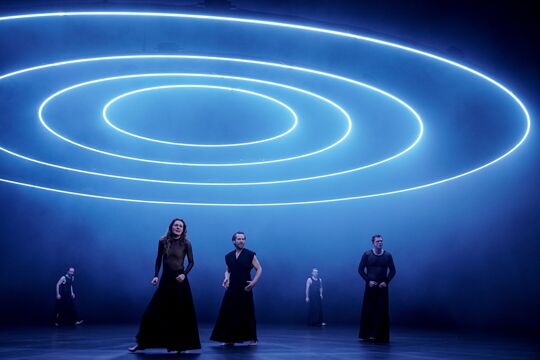
Oedipus. Directed by Ulrich Rasche. Photo: Deutsches Theater
Ulrich Rasche’s Oedipus at the Deutches Theater
I thought I had had my fill of traveling after stumbling into this performance of Sophocles’ classic directly after a seven-hour flight to Frankfurt and a further five-hour train ride to Berlin. However, I rapidly found myself transported a further 1,300 miles (and 2,400 years) by this heady production. A good portion of this distance may have been covered by the actors, who, like in much of Rasche’s recent work, are constantly in motion. In this case, the revolve at the Deutsches Theater spun at a generous clip throughout the performance, so that if an actor spoke down the center (where almost all of the speaking occurred) they had to perpetually walk to counter the spin of the turntable. This motion highlighted for me the murder-mystery element of the play. As Oedipus (played by Manuel Harder) pursues Laius’s killer, he literally chases each of his interlocutors across the revolving stage until he finds himself chased (and chasted). Adding to the air of mystery was the judicious use of fog, so thick that the actors’ entrances and exits were concealed, and they seemed to materialize from and vanish into the fog like they might in a film noir. The fog also accentuated the one scenic element present onstage: a series of concentric LED rings (suggestive of an eye?) that hovered over the stage and changed color along with the pathos of each scene.
Again, like Rache’s other recent works, the entire performance was underscored, and all of the speech had a chant-like quality, driving home the choral qualities of the chorus in Oedipus. Overall, I was struck by how the hypnotic procession of the revolving stage and the accompanied chanting drew attention to certain fundamental aspects of the theatrical event. That is, at the theatre, the audience SEES the actors MOVE and HEARS the actors SPEAK. All of this is further exaggerated because Oedipus is a play practically synonymous with the genesis of European theatre (and with European theatrical theory). It was a fantastic production that I won’t soon forget.
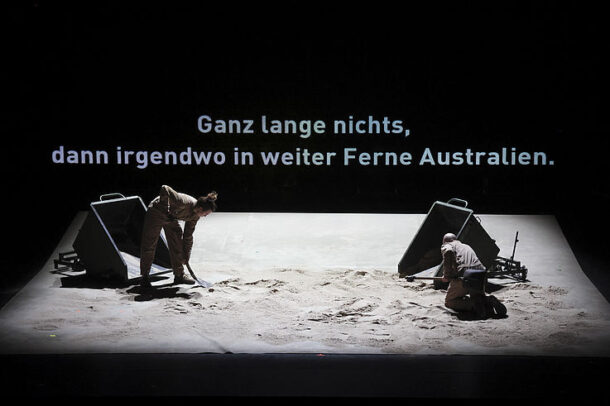
All Right. Good Night. Directed by Helgard Haug. Photo: Merlin Nadj-Toma
Helgard Haug’s All right. Good Night. at the Hebbel am Ufer (HAU)
The first of my Theatertreffen excursions, All Right. Good Night takes its title from the last recorded words of the pilot of Malaysian Airlines flight MH370. The play interweaves the story of the disappearance and searches for the ill-fated plane in 2014 with the coterminous onset of dementia in the father of director/writer Helgard Haug. This is all done with scarcely any spoken dialogue; in fact, there is never any attempt to re-enact any of the events of either story. Instead, the twin narratives are conveyed by text projected against a scrim in short sentences that alternate between the public and private tragedies. These sentences are often ambiguous enough that it is not always certain which of the two stories they are telling at any moment. As this text is projected, behind the scrim, a handful of actor/musicians with instruments provide underscoring (music by Barbara Morgenstern and the Zafraan Ensemble) for most of the show’s duration. The musicians first appear as travellers waiting to board MH370, then—as the setting (set designs by Evi Bauer) shifts from the airport and the plane itself to the various beaches where parts of the plane would later wash up—the musicians became holiday beachgoers, relaxing by the sea before returning to their instruments. This amounted to one of the most luxurious play-reading experiences I’ve ever encountered. I was struck by the manner in which the act of reading became theatricalized, with the text working in harmony with the music and the visuals. It’s not like anything I’ve seen before in the theatre and I am not surprised by its selection for the Theatertreffen.

Draußen vor der Tür. Directed by Michael Thalheimer. Photo: Matthias Horn
Michael Thalheimer’s Draußen vor der Tür at the Berliner Ensemble
The first of my two outings to the Berliner Ensemble, Thalheimer’s production of Wolfgang Borchert’s Draußen vor der Tür (often translated to The Man Outside), was visually stunning from the curtain up. The theatre went pitch-black (and it can get VERY dark in the Berliner Ensemble theater). Then what appeared to be a million colored lights twinkled and were illuminated on stage, recreating a brilliant night sky on stage. I cannot exaggerate the response this effect generated in the audience. The air went out of the room. Gradually the lights came up and the “stars” were revealed to be single-colored LED bulbs (blue, yellow, green, white, red), hung at various lengths across the whole height, width, and depth of the stage. Each LED was suspended on its own cable and swung back and forth as the actors moved past them. I have no idea how many LED bulbs there were, but to give an idea of how copiousness they were, until about halfway through the show I was convinced that the effect was an illusion achieved with inward-facing mirrors. Like Rasche’s Oedipus, the LEDs would shift color to reflect the mood and character of each scene.
For those unfamiliar with the play, Draußen vor der Tür follows Beckmann, a soldier returning from the Russian front after the end of the second World War. After attempting to drown himself in the Elbe, Beckmann is led on a tour of the afterlife of World War II—visiting a war widow, a former Nazi General, and a cabaret director, among others—by the Virgil-like “The Other.” In this production, The Other was conceived as a split personality of Beckmann (played brilliantly by Kathrin Wehlisch in a cross-gender casting choice), so their dialogues became monologues reflecting the inner turmoil of Beckmann. Particularly moving was the final speech of the play, wherein Beckmann recognizes there is no place left for him in the world and no meaning to any of the suffering he endured during the war. As the lights fade for the final blackout, Beckmann begs the audience (in direct address as in most of the play) not to leave him all alone, which of course they (we) do.
One of the more striking things about Berlin is the persistence of reminders of the trauma inflicted by Nazism and the Second World War. You cannot go two blocks (especially in the inner city) without stumbling upon some memorial to a victim of Nazi violence. Draußen vor der Tür drove home for me the degree to which Vergangenheitbewältigung (“working through the past,” the German term for recognizing, remembering, and working through the collective culpability of the German people in crimes against humanity committed by the Nazi Party) is still a palpable force in the German Theatre. I was struck by the number of people in the audience weeping as the house lights came on. The play served as a living memento of the great national sin.

Like Lovers Do. Directed by Pinar Karabulut. Photo: Krafft Angerer
Pinar Karabulut’s Like Lovers Do (Memoirs of Medusa) at the Haus de Berliner Festspiele
The second of my Theatertreffen outings was a Munich Kammerspiele production of Israeli playwright Sivan Ben Yishai’s Like Lovers Do, directed by Pinar Karabulut. It was a sensory overload experience. The play opens with a low-light ritualized dance that culminates in a circle around what I can only describe as a “vagina pool” at center stage (a pink pool inset into the stage framed by geometric renderings of labia and a clitoris). Lights up and we meet the “five best friends,” costumed as if they are about to hit up the coolest, queerest club in Berlin. In shades of cabaret, burlesque, and Sailor Moon, the five—sometimes individually and sometimes as an ensemble—recount stories of patriarchal sexual violence as well as other stories of how that same violence is embedded within the European sexual imaginary. Sex in these stories cannot be conceived outside of domination. The provenance of these stories is myriad, both from fiction and real life… I recognized Lolita, Thelma and Louise, and Lorena Bobbit, who plays a sort of focal role in the play as the vanguard of the next sexual revolution. If it has not been clear in this description, this is all done in a style of—and I understand I’m using a tautological phrase here—camp in excess of camp. In addition to the vagina pool center stage, there is a Greek colonnade of phalluses (any doubt that they are phalluses is dispelled as they go flaccid midway through the show…). For the show’s final act, the five dress up like villains you find in Power Rangers. The play ends with all five cast members flying away, two of them in the car from Blade Runner. It was the most I heard a German crowd laugh throughout my visit.

Oedipus. Directed by Thomas Ostermeier. Photo: Gianmarco Bresadola
Thomas Ostermeier’s Ödipus at the Schaubühne
This modernization of Oedipus, written by Maja Zade, was unlike anything else I saw in Germany both in that it was both largely naturalistic and mostly disappointing. Ödipus is set in contemporary Germany, at the cliffside vacation home of Christina and Michael. Christina’s former husband died several years ago, and she has inherited control of his massively powerful company has passed to her. Michael was subsequently hired at the firm, rose meteorically in the company ranks, fell in love, and married Christina, and now Christina is pregnant with their first child. Christina and Michael are very obvious Jocasta and Oedipus analogues. Christina’s brother, Robert (Creon), and their head of PR, Theresa (Tiresias), round out the four-person cast. If this description does not yet make it clear, the play twists itself in knots trying to match the Greek original. The company they run has created an environmental disaster that is causing a “plague” amongst the children of a small village in Lower Saxony. Late in the play, this environmental disaster is revealed to have occurred because Michael ran Christina’s former husband off the road while he was driving a truck carrying toxic chemicals, causing the truck to explode, and killing Christina’s husband. It’s all very contrived… Furthermore, the effect of all these forced nods and winks to the source material was unintentionally comic. I’ve never heard a crowd laugh so hard at Oedipus’s discovery of his true parentage. “Of course, you’ve murdered your father and married your mother! You’re in a play called Oedipus! What did you think would happen?!”
While I was largely unenthused by this production, I did appreciate its focus on the Jocasta analog rather than Oedipus, so that it served as a feminist counterpoint to Sophocles’ original drama. This was facilitated by the one true stand-out performance from the cast, that of Caroline Peters as Christina. So, although I am not eager to see this particular production again, it did whet my appetite for a better adaptation of Oedipus centered around Jocasta, possibly starring Peters again!
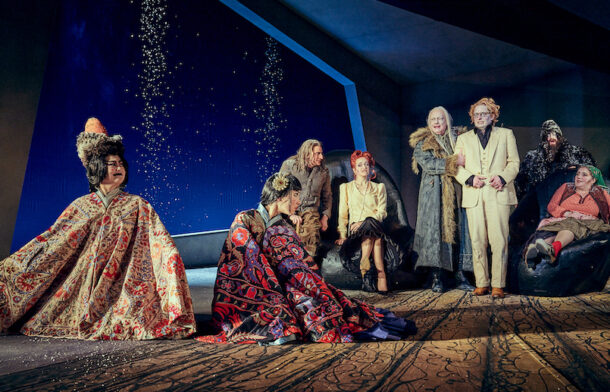
Jagdgesellschaft. Directed by Herbert Fritsch. Photo: Matthias Horn
Herbert Fritsch’s Die Jagdgesellschaft at the Deutsches Schauspielhaus Hamburg
I took a brief break from Berlin to attend Herbert Fritsch’s production of Thomas Bernhard’s play at the Deutsches Schauspielhaus in Hamburg. I had been alerted by numerous authorities that Fritsch was an innovative director of farce and Die Jagdgesellschaft (The Hunting Party) was not evidence to the contrary. I was ready to laugh right at the curtain-up. The set, designed by Fritsch, looked like something out of a Tex Avery cartoon. Throughout the whole show, there was a man in a white tie and tails (Ingo Günther) providing live underscoring. An old Nazi general’s wife has invited a playwright to stay with them at their hunting lodge. Over the course of the evening, we discovered that the woods around the lodge must be cleared due to a “bark beetle” infestation and that the general’s hangers-on are planning to push him out of his government position. The play ends with the general shooting himself in the next room. It’s a little Hedda Gabler meets The Cherry Orchard meets Bugs Bunny. The cast was incredible. Fritsch demands a lot of his actors, but he asks for exactly the kind of things that actors like to do. For example, the middle section of the play is dominated by a card game with the playwright (Bastian Reiber) and the general’s wife (Angelika Richter). Rather than using props, they had a very elaborate pantomime of the cards: shuffling the deck, throwing it back and forth, rearranging their imaginary “hands.” It was akin to the games actors might play with a pantomime ball in an introductory acting class. Another delight for the actors was the staging around the furniture on set, which consisted of primarily just two chairs. Those who have seen Fritsch’s other work will not be surprised to hear that the actors sat, stood behind, jumped on, lounged, stretched, collapsed, reclined, slunk off, mounted, and fell over those chairs in every possible way you can imagine. It was incredible. Every component of the stagecraft was equally well explored. The wife’s hoop skirt was milked for its maximal comedic effect. The actors’ interplay with the live underscoring evolved inventively over the course of the show. Every element was clearly carefully considered and iterated upon in the rehearsal and design process. As fully developed a work of theatre as I have seen.
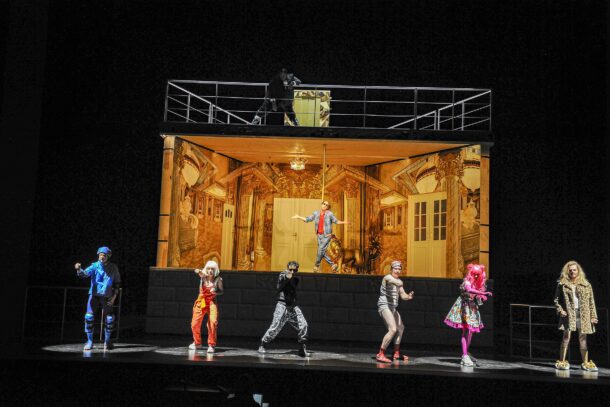
Tartuffe. Directed by Volker Lösch. Photo: Sebastian Hoppe
Volker Lösch’s Der Tartuffe oder Kapital und Ideologie at the Haus de Berliner Festpiele
On the last day of Theatertreffen, I attended this contemporary reimagining of the French classic, written by Soeren Voima and produced by the Dresden Staatsschauspiel. Before the play even “begins,” as the audience comes into the auditorium, a man—who we will later discover is Orgon—is crawling around the stage in front of the curtain, crying with his whole body. I came into the theatre late, but he was out there, wailing, for at least 15 minutes, completely incomprehensibly. Blackout and simultaneous loud crashing noise. Lights up on stage and Tartuffe bursts through the curtain and Orgon says, “Oh Tartuffe, thank God you’re here.” The first act of this play serves as a sort of prequel to Molière’s Tartuffe: over the course of the first act, Tartuffe will slowly sink his claws into Orgon and his family. In this case, Orgon’s “family” is a communal group of radical leftists living in West Berlin just before the fall of the Wall. After a short introductory scene in front of the curtain between Orgon, Tartuffe, and Madame Pernelle (who, in keeping with tradition, is played by a man in drag), the curtain is raised to reveal Damis, Valere, Elmire, and Mariane having communal sex (none of them are related in this version, and they are all in their early twenties) atop of Orgon’s ancestral home. Orgon’s home is a multi-room set (designed by Cary Gayler) that is almost always spinning on its turntable and the actors crawl from room to room through doorways and by swinging around the outside of the set. Orgon’s “family” has torn his ancestral home up, and blasts German rock music at all hours. Orgon brings Tartuffe into the family, and he presents himself as a Positive Energy/New Age Guru and begins to twist the family’s leftist identities into Neoliberal ones. All of the family—save Elmire—are convinced to abandon operating strictly as a collective. At the end of the first scene the Wall falls, and Cleante (in this version Klaus), Orgon’s GDR cousin, immigrates to West Berlin and gives an impassioned speech about the evils of collectivism as the curtain closes to cover a massive scene change. Afterward, the curtain is raised and it’s the booming 90s, and Orgon is renovating his building and charging rent to his former collective. Tartuffe, who gets fatter and fatter as the play goes on further ingratiates himself with every member of the family except Elmire who tells off the whole group and then leaves. The final scene of the first act takes place in the early ’00s in the newly built penthouse at Orgon’s home, where Tartuffe manages to convince each of the family members to take out loans on bad terms so they can own homes. The act ends with Elmire, now an investigative journalist, returning.
Act 2 begins with a classic sequence from Tartuffe: Orgon hides under a table as Elmire interviews Tartuffe. Tartuffe is revealed to be a CIA operative that worked to disrupt leftist governments in Chile and has a history of pushing people down elevator shafts. He plans to fleece Orgon and the rest of the family in the impending sub-prime mortgage crash. He then, in a way that is distinct to German theatre, rapes Elmire in a fashion that is, if not comical, not presented with what might be considered an appropriate level of pathos. It was not even clear to me that a rape had occurred until much later in the play when the role of the Royal messenger is fulfilled by Elmire’s daughter by Tartuffe. She, a girl of fewer than ten years, orchestrates Tartuffe’s death by having him fall down the shaft of a golden elevator. Just after he dies, the lights change, and the actress playing Elmire comes out in her street clothes and says something to the effect of “But in real life, the Tartuffes never die.” She then gives what amounts to a TED Talk on Thomas Piketty’s 2019 book, Capital and Ideology. The final act of the play is just the actors in their street clothes taking turns talking about the growth of inequality in the time period covered by the play, and possible solutions suggested by Piketty.
I was struck by both the abruptness and the duration of this final stretch of the show. This extended lecture lasted at least a quarter of the show’s runtime. They have time to get into the nitty gritty of Piketty’s argument, and I’m somewhat unclear as to what purpose it served. It appears that the events of the play are illustrative of the patterns Piketty identified in the ideologies surrounding global capital, but I—and I imagine most of the audience—caught on to that long before the lecture. I made the connection between Molière’s religious hypocrite Tartuffe, and Voima’s sub-prime mortgage banker without having it spelled out for me at the end of the show. The theatrical play was clear enough without the non-theatrical (or as theatrical as a lecture can be) lecture. I left the theatre with questions about the audience. Who were this play and the attendant lecture for, given that it was not for someone like me? What does the Staatsschauspiel Dresden expect of its audience?
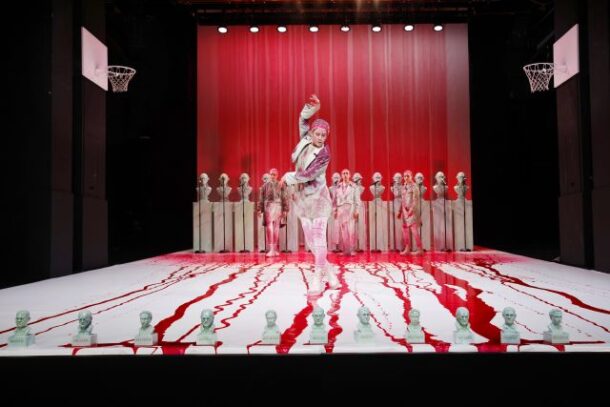
DantonsTod/Iphigenie. Directed by Oliver Frljić. Photo: Ute Langkafel
Oliver Frljić’s Dantons Todt/Iphigenia at the Maxim Gorki
This mash-up of Büchner’s Death of Danton and Euripides’ Iphigenia in Aulis was my least favorite performance this trip. Four women, all insane asylum attendants/patients, proceed through a series of sequences illustrating key speeches from Iphigenia and Danton, although there was considerably more Büchner than Euripides. I was unimpressed by the content and execution of these illustrations. For example, during one sequence a speech given by Robespierre about the Terror is read over a loudspeaker as the four actresses take turns shooting a basketball into a hoop. Every time they sink a basket, the sound of a falling guillotine blade plays. The metaphor is blunt: for some, political violence is a game. This is not a particularly revelatory sentiment in itself, but it provides a visually interesting stage picture. However, this was undercut by the poor aim of the actresses. With their shooting percentage, the Terror would not have been so terrible.
I would extend my feelings about this sequence—that it had nothing nuanced to say about political violence and that what it did have to say was poorly executed—to the rest of the play. It literally rained blood at one point and there was another sequence with a jump rope… It was all visually interesting but added nothing to either of the original German or Greek texts. I suspect the production stills were better than the performance.
Thom Luz’s Werkmeister Harmonien at the Staatsoper Unter Den Linden
The most pleasant surprise of my trip! This new work written and directed by Thom Luz (with musical arrangements by Mathias Weibel) was about piano tuners, the theory of tuning, and the work of 17th-century music theorist Andreas Werkmeister. The piece involves four brilliant musician/actors and about 12 pianos, an organ, a large harpsichord, and a whole lot of tuning equipment. Much of the play was watching the ensemble tune each of the instruments, and the music they made together as they tuned. I’ve never asked my ears to work harder. Over the course of the play, I found myself—a musical novice—becoming attuned to the minuscule variations of tones between the different instruments. The effect followed me outside of the theatre. I caught myself noting the harmonies and discords between the different trains at the U-Bahn station! It was a strikingly beautiful and affecting piece.

Threepenny Opera. Directed by Barry Kovsky. Photo: Jorg Bruggemann
Barry Kovsky’s The Threepenny Opera at the Berliner Ensemble
I extended my stay in Berlin just to catch this performance, and I do not regret the decision. Like Kovsky’s work in operetta, his Threepenny was glitzy, gaudy, and had its tongue firmly planted in its cheek. The first few numbers all took place in front of a silver mylar fringe curtain. During the wedding scene, Mac’s gang (Crook-fingered Jake, Bob the Saw…) was played by members of the orchestra. So as Mac (Nico Holonics) berates them, he is simultaneously also the lead actor berating the orchestra. At one point he grabbed the score from the conductor and ripped it apart. He also “stole” their food. At this point a brief there was a failed attempt at audience participation, with Mac asking members of the audience to sing a song for his wedding. No one took him up on it and Polly broke out into “Pirate Jenny.”
At this point, the mylar curtain was finally raised and the set was properly revealed. I would describe it as an art deco, labyrinthine, jungle gym. It had a myriad of platforms and ladders for the actors to climb and swing to and from. Late in the first act, the four sections of the jungle gym are revealed to be able to move upstage and downstage on tracks independent of one another. It was very effective at creating both levels and depth on stage, and it imbued a great sense of physicality in the actors as they climbed around it, such as when Tiger Brown, who managed to flip, acrobat-like, from an upper level down to a lower one during the “Cannon Song.” This role was played in breeches by the same brilliant actress who played the leading role in the Draussen vor der Tor, Kathrin Wehlisch. She was terrific again.
Other notable moments/characters: Both Lucy (Laura Balzer) and Polly (Cynthia Micas) were phenomenal, as was their “Jealousy Duet.” A shocking moment came after Mac’s escape from prison. He was pursued by a policeman through the jungle gym, and when the policeman finally caught him, Mac slashed his throat and blood went everywhere, including all over Macheath, who had blood all over his face for the remainder of the show. It was a nice Brechtian moment that drove home the violence embedded in the character that is sometimes lost or forgotten in the musical. As the play comes to its conclusion, they hang Macheath, with the actor contorting and twisting during his death throes, but they unhang him right afterward for the final number with the royal messenger. At the very end, the words “LOVE ME” in giant block letters fly down behind Macheath. I had a good chuckle. Perfect camp. Perfect Brecht. A perfect end to my sojourn in Berlin.
Philip Wiles is a Ph.D. student in the Theatre and Performance Program at the CUNY Graduate Center. His research interests include: the performance of humor, collective playwrighting practices, and Hollywood comedies. He is a former managing editor of European Stages.

European Stages, vol. 17, no. 1 (Fall 2022)
Editorial Board:
Marvin Carlson, Senior Editor, Founder
Krystyna Illakowicz, Co-Editor
Dominika Laster, Co-Editor
Kalina Stefanova, Co-Editor
Editorial Staff:
Asya Gorovits, Assistant Managing Editor
Zhixuan Zhu, Assistant Managing Editor
Advisory Board:
Joshua Abrams
Christopher Balme
Maria Delgado
Allen Kuharsky
Bryce Lease
Jennifer Parker-Starbuck
Magda Romańska
Laurence Senelick
Daniele Vianello
Phyllis Zatlin
Table of Contents:
- AVIGNON 76. A Festival of New Works by Philippa Wehle
- Almodóvar’s Women on the Verge in Portugal by Duncan Wheeler
- BRACK IMPERie. About “Hedda Gabler” by Vinge/Müller at Norske Teatret Oslo by Thomas Oberender
- Embodied Intimacy: The Immersive Performance of The Smile Off Your Face at Edinburgh by Julia Storch
- Fear, Love, and Despair – Radu Afrim: Director of Core Feelings by Alina Epîngeac
- Grec Festival de Barcelona, July 22 by Anton Pujol
- I Think of Curatorial Work in Scholarly Terms: An Interview with Ivan Medenica by Ognjen Obradović
- New Worlds Revealed in an Immigrant Journey, and an Unexpectedly Meaningful Universe Discovered and Destroyed Inside Styrofoam, at the Edinburgh Festival by Mark Dean
- Participation, Documentary and Adaptation: Barcelona Theatre May 2022 by Maria Delgado
- Report from Berlin, April 2022 by Marvin Carlson
- Report from Berlin (and Hamburg….) 5/2022 by Philip Wiles
- The Sibiu International Theatre Festival Transforms Dreams into Reality (The Magic of 2022 FITS in Short Superlative) by Ionica Pascanu
- Theatre in Denmark and The Faroe Islands – Spring 2022 by Steve Earnest
- The Polish Nation in a Never-Landing Aircraft by Katarzyna Biela
- The Piatra-Neamt Theatre Festival in Romania: 146 Kilometers from Heart to Heart by Cristina Modreanu
- Will’s Way at the Shakespeare International Festival Craiova 2022 by Alina Epîngeac
- Interview with the Turkish theatre critic Handan Salta on TheatreIST by Verity Healey
www.EuropeanStages.org
europeanstages@gc.cuny.edu
Martin E. Segal Theatre Center:
Frank Hentschker, Executive Director
Marvin Carlson, Director of Publications
©2022 by Martin E. Segal Theatre Center
The Graduate Center CUNY Graduate Center
365 Fifth Avenue
New York NY 10016
European Stages is a publication of the Martin E. Segal Theatre Center ©2022


